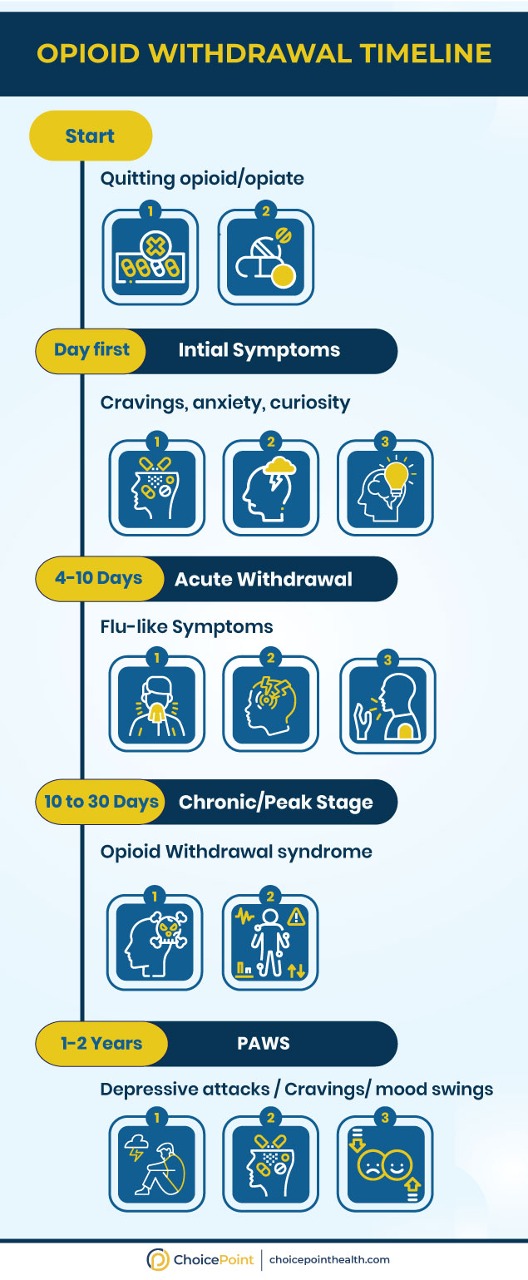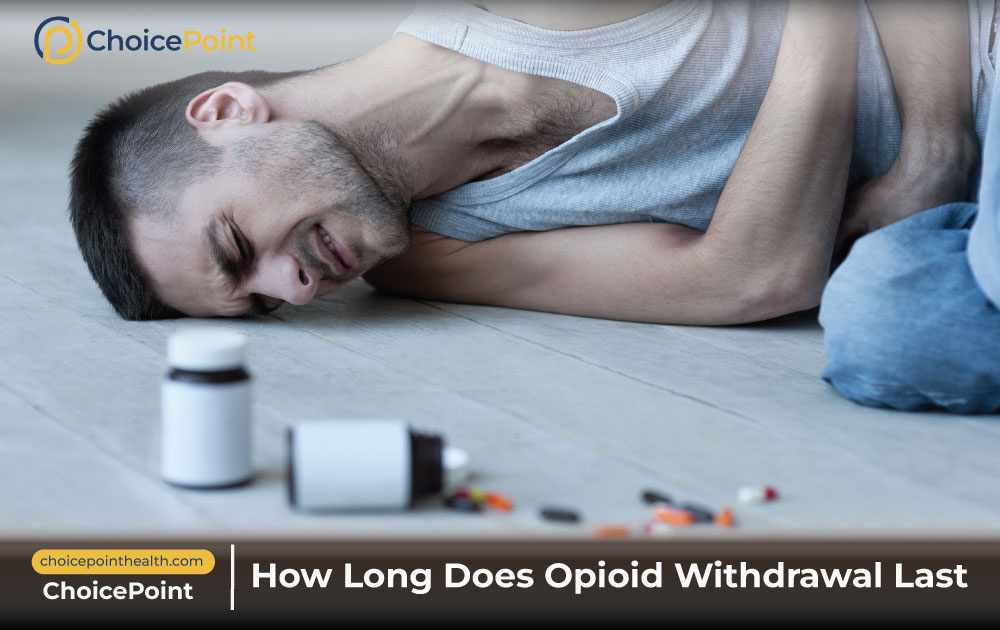Ending April 2023, there were around 111,000 deaths due to drug overdose. Opioids, including fentanyl and other synthetic ones, account for more than 70% of these deaths, according to the CDC. Before getting treatment for opioid use disorder (OUD), people often pose the question, ”How long does opioid withdrawal last?”. This blog gives an overview of opioids, opiates, their withdrawal timelines, and addiction treatment procedures.
Choicepoint offers safe and secure MAT-assisted opioid withdrawal in inpatient rehab. Call Now 844.445.2563 to book your appointment!
Table of Contents
Opioids and Opiates: What Do the Dangerous Narcotics Hold
As the opioid crisis is looming on the streets, it is imperative to know why such drugs are used in the first place. Opioids derived from opium plants (opiates if naturally derived) or sometimes prepared in laboratories (synthetic) are used for medicinal as well as recreational purposes.
Medicinal ones (prescription opioids) are prescribed for pain management during surgery, cancer, or accidents. These drugs specifically bind to opioid receptors in the brain, producing a sensation of euphoria and relaxation while curbing pain. Some opiates include:
- Morphine
- Codeine
- Thebaine
Opioids include:
Out of 80,000 opioid-related deaths in 2021, 88% involved synthetic opioid misuse such as fentanyl.
How Long Does Opioid Withdrawal Last- Expected Timelines
Opioid withdrawal is a side effect that many people fear or, at worst, don’t go for due to its unpleasant and fatal consequences. Opioid withdrawal occurs when someone dependent or addicted to opioids suddenly or gradually stops using them. Since they affect the brain, opioid withdrawal comes with many unpleasant symptoms and side effects that require detox and psychotherapy to maintain and alleviate.
Factors Affecting Opioid Withdrawal Timeline
While most of the withdrawal timelines are similar, the significant difference comes due to the following factors:
- The type of opioid misuse, such as long-acting or short-acting opioids.
- Duration of opioid use.
- A person’s physical and mental health.
- The severity of the substance use disorder (SUD).
- Age, i.e., older people, are likely to experience severe withdrawal.
- Genetic.
- Concurrent use of other drugs such as alcohol, cocaine, meth, etc.
- Co-occurring conditions such as SUD and mental illness.
 Alarming Facts: Recent Polls revealed that 3 out of 10 adults admitted that they or their loved ones were involved in opioid addiction once in a lifetime.
Alarming Facts: Recent Polls revealed that 3 out of 10 adults admitted that they or their loved ones were involved in opioid addiction once in a lifetime.
Opioid Withdrawal Symptoms and Timeline
Every opioid produces different types of withdrawal symptoms and has varied timelines of withdrawal. Generally, they are divided into two main categories with two main phases:
Acute Withdrawal Phase
This phase starts between 6 and 12 hours after the last dose and can take up to 10 days, depending on the abovementioned factors. Short-acting opioids usually peak their side effects in this phase.
Chronic (Peak) Withdrawal Phase
This phase starts with the acute one, but when it enters the 11th day with more psychological and emotional symptoms, it is termed the chronic phase. Long-acting opioids play a significant role in persistent chronic withdrawal, whereas it can take up to a month or longer to completely exit this phase.
Short-Acting Opioid Withdrawal
These opioids, as mentioned below in the standard question section, show intense and short-term symptoms that begin from the start of withdrawal to up to 10 days, depending on the body’s metabolism:
- Gastrointestinal discomfort
- Shivering
- Fatigue,
- Abdominal cramps
- Anxiety
- Muscular aches
- Sleep disturbances
These symptoms are short-lived but can be severe if not appropriately managed due to the aggressive nature of opioid dependence in the brain.
Long-Acting Opioid Withdrawal
As explained below, long-acting opioids generally peak symptoms in the chronic phase and can stay for as long as 30 days. Some common symptoms include:
- Diarrhea
- Vomiting
- Hypertension (high blood pressure)
- Loss of appetite
- Insomnia
- Irritability
Long-acting opioids are not very intense but accompany more of a psychological nature and affect people with mental illness the most. So, dual diagnosis treatment is best to treat such complications.
Post-acute Withdrawal Syndrome (PAWS)
One of the most significant effects of opioid addiction is the post-acute withdrawal syndrome (PAWS) that some people may experience. It can last for up to 1 year, involving mild symptoms appearing from time to time, such as:
- Depressed or irritable mood
- Fatigue
- Sleep disturbances
- Drug cravings
- Depression and anxiety
PAWS is common in people with severe addiction to opioids and usually requires medical maintenance, as explained in the treatment guidelines below.

How Long Does Opiate Withdrawal Last?
Opioid Detox: Treatment for Opioid Use Disorder
The details of how the opioid withdrawal timeline can be shortened and observed with fewer side effects lie in the treatment guidelines.
Opioid Detox Drugs in Medically Managed Opioid Detox
Opioid withdrawal is a complex series of side effects, unpleasant timelines of withdrawal symptoms, and psychological disturbances that require a comprehensive detox. Which involves catharsis of the whole body while administering FDA-approved medications such as:
- Buprenorphine (Subutex, Suboxone) is given anywhere between 12 to 18 hours after the last use of short-acting and 24 to 48 hours of long-acting opioids
- Naltrexone for blocking opioid receptors to reduce cravings throughout the withdrawal timeline
To reduce general symptoms on the onset, practitioners may dispense:
- Loperamide for diarrhoea
- Promethazine for nausea/vomiting
- Ibuprofen for pain
- Clonidine to reduce blood pressure
Only DEA-registered practitioners with Schedule III authority are allowed to dispense these medications, so it is advisable to opt for a reputable registered inpatient facility for opioid detox.
 Can You Believe That? CDC reports revealed an increase in fake prescription drugs had doubled overdose deaths in recent times, and more than 90% of those are made from the synthetic opioid Fentanyl!
Can You Believe That? CDC reports revealed an increase in fake prescription drugs had doubled overdose deaths in recent times, and more than 90% of those are made from the synthetic opioid Fentanyl!
Dealing With Co-occurring Disorder: Substance Use and Mental Illness
It is common for opioid users to experience mental illness, and often, one becomes the cause of another, paving the way for disorders such as:
- Depressed mood
- Persistent depressive disorder (dysthymia)
- Opioid-induced depressive disorder
- Bipolar disorder
- Post-traumatic stress disorder
Sometimes, people misuse concurrent substances and may experience withdrawal from them, such that withdrawal associated with sedatives, such as benzos, give opioid-like withdrawal symptoms. But opioid withdrawal will be more intense involving:
- Lacrimation
- Rhinorrhea
- Pupillary dilation.
Hallucinogen and stimulant intoxication, along with opioids, can also cause pupillary dilation but will not accompany opioid withdrawal symptoms, such as nausea, diarrhea, vomiting, lacrimation, and rhinorrhea.
For such complex conditions, dual diagnosis treatment will be required that will holistically approach a person’s addiction and mental illness, paving the way for a new sober living.
Psychotherapy and Counseling for Complete Mental Catharsis
As addiction is a chronic brain disease and opioid is specifically associated with mental health disorders, psychotherapies such as:
- Cognitive Behavioral Therapy (CBT) mending negative behaviors
- Dialectical Behavior Therapy (DBT) alleviates excessive emotions
It will reduce psychological symptoms and disorders. These therapies are given from time to time during peak withdrawal stages to assist in alleviating symptoms of withdrawal.
According to DSM-5, The prognosis of opioid withdrawal is directly or indirectly associated with the involvement of family members, peer support, and the environment around the person, so psychiatrists will dispense the following therapies:
To counter social factors that previously aggravated opioid dependence and prevent recurring relapses.
Careful Management of Opioid Withdrawal At ChoicePoint Inpatient Rehab
It’s not about “How long does opioid withdrawal last?”. It’s about how well you can manage it. Choicepoint, with its personalized opioid treatment program, can help you manage it in a timely with the least possible consequences. We have treatments for
Read our patient’s treatment journey in their own words:
 “I don’t know where to begin. I have been with ChoicePoint for about 2 years. Ever since joining, I feel my life has turned around. I would not be where I am today if it wasn’t for Samantha. She has been my counselor ever since joining. Samantha helped me through this journey since day one. I can not thank her enough. She has always been there for me through the good times and bad. I look forward to meeting with her every month because she knows how to help me through all the bad times I’ve had. My relationship with my wife and kids would not be how it is if it wasn’t for Sam helping me get through this. She has even helped me overcome the tension with my inlaws. Again, Samantha, thank you for returning me to this position. My life has not been as good and successful as I can remember. You are the best counselor anyone can ask for ! ”Shpendi Klobucista– ChoicePoint Alumna
“I don’t know where to begin. I have been with ChoicePoint for about 2 years. Ever since joining, I feel my life has turned around. I would not be where I am today if it wasn’t for Samantha. She has been my counselor ever since joining. Samantha helped me through this journey since day one. I can not thank her enough. She has always been there for me through the good times and bad. I look forward to meeting with her every month because she knows how to help me through all the bad times I’ve had. My relationship with my wife and kids would not be how it is if it wasn’t for Sam helping me get through this. She has even helped me overcome the tension with my inlaws. Again, Samantha, thank you for returning me to this position. My life has not been as good and successful as I can remember. You are the best counselor anyone can ask for ! ”Shpendi Klobucista– ChoicePoint Alumna
And get yourself started with a remarkable journey of sobriety 844.445.2563.
Common Questions Regarding Opioids
Some of the most important and common queries regarding opiates and opioid withdrawals are:
Are Opioids and Opiates the Same?
No! Opioids are a broader term consisting of all the natural, semi-synthetic, and synthetic drugs, such as:
- Fentanyl
- Heroin
- Tramadol
Whereas opiates are a natural class of opioids directly derived from poppy plants, such as:
- Morphine
- Codeine
All opiates are opioids, but not all opioids are considered opiates.
Do Opioid and Opiate Withdrawal Have the Exact Timelines?
The withdrawal timeline depends on the type of opioid, as long-acting opioids have longer timelines, usually 10-20 days, including:
- Methadone
- Hydrocodone
- Oxycodone
- Oxymorphone
Whereas short-acting opioids have a lesser timeline, usually 4-8 days:
- Heroin
- Codeine
- Oxycodone
- Oxymorphone
- Morphine
There’s no such difference associated with opiate or opioid as both are simple terms for different compound types of same class drugs.
Can You Die From Opioid Withdrawal?
Yes! It is a general perception that opioid withdrawal is unpleasant but not life-threatening. Still, in reality, it can be complicated to the level of fatality if professional help is not considered or if the symptoms are managed inadequately.
Is Cold-Turkey Opioid Detox Safe?
No! There’s no quick fix for opioid use disorder (OUD). Quitting on your own or suddenly will give way to severe withdrawal symptoms such as
- Severe dehydration
- Brain dysfunction, i.e., Extreme confusion
- Muscle twitches
- Seizures
- Coma
- Death
So, the easiest way to deal with addiction is to taper away opioid dependence with professional help.
Is Xanax Safe for Opioid Withdrawal?
Xanax, a benzodiazepine, might be an effective treatment option for mental illnesses such as anxiety, depression, and insomnia. Due to its potential dependence and side effects, Long-term use may develop an addiction, so it is like trading one disease for the other with much more severe side effects. It is recommended to seek professional guidance through inpatient rehab to check whether Xanax is a good fit for you or not!
What Happens During Opioid Withdrawal?
Opioid withdrawal is accompanied by varied withdrawal symptoms, including
- Nausea and vomiting
- Panic attacks
- Severe cravings
- Breathing, blood pressure, and heart complications
- Body pains
If someone is going through opioid detox, they will likely experience withdrawal, but professionals will be able to ease these symptoms without complications. However, if it is done cold turkey, the symptoms might complicate the fatality.
How Long Will Opiate Withdrawal Last?
There’s no definite timeline for opioid withdrawal, but one can expect a timeline of 8 hours from the last dose to up to 30 days of withdrawal symptoms appearance.
Medical Disclaimer:
ChoicePoint aims to improve the quality of life for people struggling with substance use disorder and mental health issues. Our team of licensed medical professionals research, edit and review the content before publishing. However, this information is not intended to be a substitute for professional medical advice, diagnosis, or treatment. For medical advice please consult your physicians or ChoicePoint's qualified staff.











I appreciate the work you did on this and thank you for all the wonderful stuff.